



Backgrounding Calves on Co-products
As cow-calf producers look to add value to their calf crop, backgrounding or pre-condition of cattle may be one potential management option, write Matt Hersom and Jacquline Wahrmund. This publication is part of the University of Florida IFAS, 2008 Beef Cattle Short Course Proceedings. To view the entire proceedings please click on the link provided below.Backgrounding Calves on Co-products As cow-calf producers look to add value to their calf crop, backgrounding or pre-condition of cattle may be one potential management option, write Matt Hersom and Jacquline Wahrmund. This publication is part of the University of Florida IFAS, 2008 Beef Cattle Short Course Proceedings. To view the entire proceedings please click on the link provided below.
Introduction
The process of backgrounding cattle involves weaning, vaccination, and acclimating cattle to eating from feed bunks (Savell et al., 2007a,b). Most often calves are backgrounded on a forage or roughage-based diet with supplemental feeds offered to achieve the desired level of performance.
Like many management scenarios associated with beef cattle production, the greatest cost associated with backgrounding programs is the feed cost. In many cases, beef cow-calf producers who wish to background their calves have the capacity to store/handle only one or two co-product commodities.
Selection of the co-product(s) utilized should be based upon optimizing the nutrients supplied to compliment the basal forage, co-product palatability, and per unit price of energy and protein. Supplement feeds that are high in fermentable fiber and low in starch provide the most effective sources of energy for cattle on high-forage diets, as starch may interfere with fiber digestion within the rumen (Richards et al., 2006). This discussion will focus on the nutrition, feedstuff considerations, and performance potential for different co-product options in backgrounding management.
Performance Expectation
The backgrounding period bodyweight gain can be difficult to predict because of the myriad of factors that affect bodyweight gain (Lalman et al., 2002). The factors affecting bodyweight gain include: health status, resumption of feed intake after weaning, amount of forage and supplement consumed, energy and protein concentration of diet, length of the feeding period, and previous plane of nutrition.
Weighing conditions can have a large effect on the bodyweight gain observed; calves are capable of consuming between 0 and 4 per cent of their bodyweight in feed which can result in large differences in bodyweight. Likewise, because the backgrounding period utilizes light weight calves and short feeding durations, the bodyweight gains can be small.
However, even small bodyweight gains can have positive differential effects on subsequent calf performance because of a successful backgrounding phase. An important consideration for the backgrounding period is the total bodyweight gain of the calves. If the calves are to be retained by the producer and moved into an accelerated growth phase, then moderate bodyweight gains may be appropriate.
In contrast, if the calves are to be sold after the backgrounding period, then greater bodyweight gain may be desirable to increase the pounds of calves marketed, optimizing feed efficiency use, and positioning of the calves to enter any variety of subsequent management phases.
Feedstuff Selection
Generally, the backgrounding period is the calf’s first introduction to dry feed, thus selection of feedstuffs to compliment the forage base in Florida deserves some consideration for a successful backgrounging program. In order for the calf to get any nutritional value from the feeds, the feedstuff must be consumed, so a palatable feedstuff is an important consideration for starting calves.
The utilization of a highly palatable feedstuff will minimize the length of time that calves go without feed, potentially decreasing transition stress and the resulting bodyweight loss (Lalman et al., 2002).
Co-products generally considered to be palatable include soybean hulls (SBH), soybean meal (SBM), corn gluten feed, and citrus pulp among others. To lesser extent co-products such as dried distiller’s grains (DDG), brewers grains, and whole cottonseed (WCS) are palatable to backgrounding calves. An important consideration when working with co-products is the variability of the product itself.
The variability of feedstuffs will affect acceptability of the feedstuff by cattle and the nutrient concentrations of the feed. The next consideration is the supply of nutrients that a co-product will supply to the overall diet. Because of the limited dry matter intake potential of young growing calves, co-product nutrient concentrations have to be great enough to supply nutrients to meet calf nutrient requirements.
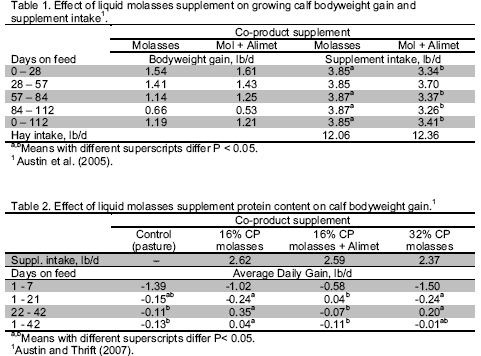
Backgrounding Research at UF
The Department of Animal Sciences has conducted a number of backgrounding research experiments examining different co-product feeds. A number of universities conduct experiments that examine backgrounding nutrition programs and utilizing the results from that work is important. However, UF research has been conducted with Florida adapted cattle, available feedstuffs, and importantly Florida forages including bahiagrass and bermudagrass hay and pastures. Following are brief summaries of research utilizing a number of different feedstuffs. Feedstuffs that are covered here include: soybean hulls, soybean meal, whole cottonseed, dried distillers grains, and molasses slurries.
Molasses Slurries
Following are three experiments that utilized molasses slurries to background growing beef calves. Liquid molasses is a high energy, palatable, co-product that is often utilized as a supplement in Florida. However, blackstrap molasses is deficient in crude protein (CP) relative to the requirements of growing cattle.
Therefore, nitrogen or protein containing feeds or products are added to liquid molasses to create slurries that better meets the nutrient requirements of growing cattle. Austin et al. (2005) examined the addition of bypass methionine (Alimet) to liquid molasses as a supplement for Angus x Brahman steers and heifers fed bermudagrass hay (Table 1). Methionine is considered the first-limiting amino acid to growth in beef cattle; therefore the use a synthetic methionine source to augment the protein content of liquid molasses was of interest. Liquid molasses supplement intake was targeted for 6 lb/hd/day, bermudagrass hay quality was moderate (11 per cent CP) and late in the backgrounding period bahiagrass pasture regrowth was available. The addition of Alimet to the liquid molasses supplement did not increase calf bodyweight compared to the molasses alone during any 28-day period.
However, supplement intake was generally lower than expected and the addition of the Alimet depressed liquid molasses supplement even more. The lack of response to the additional amino acid supply with the Aliment product was likely a result of the adequate protein provided by the bermudagrass hay and bahiagrass pasture that was available. The use of molasses as a supplement likely improved calf bodyweight gain compared to calves if no additional energy had not been available from molasses.
In another study, Austin and Thrift (2007) examined the effect of CP concentration supplied by urea or the addition of Ailment in liquid molasses on Angus and Brangus steer and heifer bodyweight gain when backgrounded on bahigrass pasture (Table 2).
Liquid molasses was supplied via lick tanks for ad libitum consumption. This experiment is an excellent example of the variability and sometime difficulty in making backgrounding programs work. Bodyweight gains of the calves from all treatments were negative indicating moderate bodyweight loss during the first week of the backgrounding phase. In many cases, the shrink associated with weaning, stress, and diet changes are manifested in large bodyweight losses early in the backgrounding period.
In comparison, the bodyweight changes during the remaining days on feed were much more moderate. As a rule, the incorporation of urea as the sole or major source of nitrogen/protein should be avoided in growing calf diets. Growing cattle have requirements for amino acids that cannot be met by using urea, rather sources of natural protein are a better choice for growing backgrounded cattle.
The use of different protein sources, including natural protein, added to liquid molasses was examined by Stateler et al. (2001). The use of liquid molasses improved calf bodyweight gains compared with pasture/hay fed control cattle (Table 3). There was no difference in bodyweight gain between molasses or molasses+urea.
In contrast, the incorporation of SBM or a natural by-pass protein source increased calf bodyweight compared with control, molasses, or molasses+urea. The results of Stateler et al. (2001) highlights the requirement of growing cattle for adequate levels of undegradable intake protein which supplies intake amino acids that support growth.
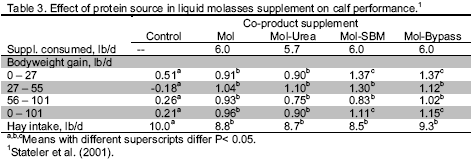
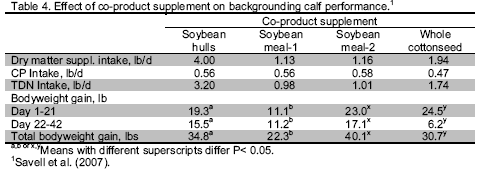
Commodity Co-products
A number of commodity co-products that are available to Florida beef cattle producers have been examined as potential feedstuffs. Savell et al. (2007a,b) conducted two trials that compared the use of SBH or WCS to SBM (Table 4). In both trials, the supplements were fed to supply 0.6 lb/hd/day of CP, therefore actual amounts of supplement offered and consumed were different between treatments as a result of the different CP concentration of the feedstuffs.
The first trial compared feeding SBH to SBM to background calf Angus x Brahman steers and heifers calves grazing bahiagrass-bermudagrass pastures. Because the supplements were fed to supply similar CP, nearly 3 lbs more SBH were fed compared to SBM, as a result approximately 2.2 lb/d more total digestible nutrients (TDN) was offered in the SBH group compared to the SBM supplemented calves.
The greater amount of TDN supplied by the SBH resulted in greater bodyweight gain during the first and second 21 days and across the entire 42-day trial. These results highlight the critical importance of an adequate energy supply in promoting an acceptable level of bodyweight gain during backgrounding. In the second trial, SBM was compared to WCS. Again, a similar amount of CP was offered to the calves, and because of differences in CP concentration of the feedstuffs, different amounts of supplement were offered. The amount of TDN offered was much more similar than in the first trial and as a result, bodyweight gain while different during the first 21 days was more similar than the SBM-SBH trial. However, during the second 21 days of the trial, bodyweight gain of the WCS supplemented calves was decreased dramatically resulting in nearly a 10 lb difference in gain during that period.
WCS resulted in 0.73 lb/day more TDN intake, that energy was being supplied in the form of fat from the WCS. The high intake of fat supplied by the WCS likely resulted in a eventual feed refusal by these growing calves. The pattern of supplement intake of the SBM and WCS supplements is shown in Figure 1. During week 1 supplement intake was stepped-up to acclimate calves to the feedstuffs.
However, the WCS calves never consumed the desired amount of WCS and consumption began to fall during week 4, ending at approximately 65 per cent of the desired level of consumption. In this case, WCS presents a nutritional profile (adequate TDN and CP), but consideration needs to be given to the feeding characteristics associated with the WCS product and its overall acceptability as a sole co-product supplement for backgrounding calves.
At the time of the trial a simple economic analysis was conducted to examine the use of SBH, SBM, and WCS as co-products to background calves (Table 5). Considerations for the additional bodyweight gain, price slides for bodyweight, and backgrounding costs were incorporated. The increased bodyweight gained associated with feeding SBH in trial 1 and SBM in trial 2 resulted in increased calf value and a profit over non-backgrounded calves. However, in trial 1, the use of SBM to background calves resulted in an estimated loss of $0.41 per calf as a result of inadequate bodyweight gain to offset the cost of the SBM offered. In trial 2, WCS did add profit to backgrounded calves, but as a result of the comparatively less calf weight gain during backgrounding, the profit associated with WCS was less than calves backgrounded with SBM.
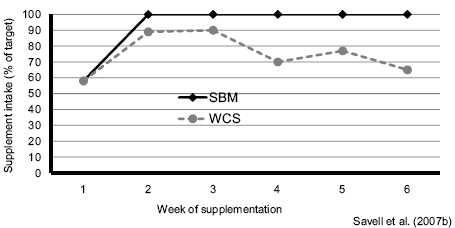
The likely cause of the decreased bodyweight gain was the cumulative effect of dietary fat intake by the calves offered the WCS supplement. While the
Both SBH and DDG can be utilized as low starch feed resources for backgrounding cattle. However, little data exist that directly compares these two co-products or in proportional combinations as supplements to high forage diets for backgrounding cattle. Even less data exists when utilizing these co-products with subtropical forages in the Gulf Coast region. It was our objective in some recent work to compare SBH and DDG alone or in combination as supplements for backgrounding steers on high forage diets.

Supplements containing DDG, DDG/SBH, SBH/DDG, and SBH were formulated to supply approximately 5.0 lb/hd/day of TDN to Angus calves that were consuming bahiagrass hay free choice. During the first 14 days of the feeding period, steers in the DDG treatment had ADG that was 55 per cent less compared to steers in the SBH/DDG or SBH treatments (Table 6). From day 14-42, steer ADG did not differ among supplement treatments. However, it is noteworthy that SBH treatment steers gained 0.57 lb/day less compared to the other treatments.
Across the 42-day feeding period, ADG of SBH supplemented steers was less compared to DDG/SBH and SBH/DDG supplemented steers; DDG supplemented steers were intermediate. Supplement type did not affect estimated mean hay intake. Interestingly, the single co-product supplement treatments (DDG or SBH) had similar estimated mean hay intake that was numerically less than the combination of co-product supplement treatments.
Estimated mean hay intake for DDG steers was potentially depressed by the level of total fat in the diet (7.7 per cent) as a result of the amount of DDG offered. The SBH treatment estimated mean hay intake was potentially depressed by consumption of greater amounts of fiber in the total diet. Steers that were offered supplements that contained DDG (DDG, DDG/ SBH, SBH/DDG) had gain efficiencies that were greater compared to SBH supplement treatment steers.
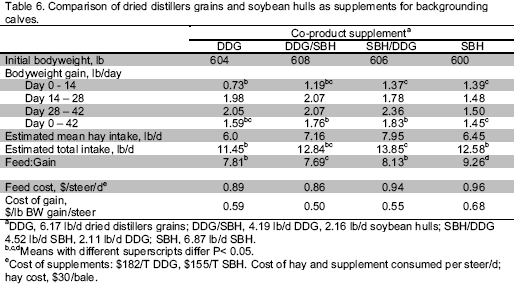
A simple economic analysis was conducted to determine the optimal supplement treatment combination. The daily feed cost per steer did not differ among treatments and had a range of $0.86 to $0.96. This cost includes both supplement and estimated hay intake. Calculated cost of gain was not different among treatments because feed costs were not different and BW gains were not drastically different. Regardless, there appears to be an economic advantage for utilizing a combination of DDG and SBH supplements rather than feeding DDG or SBH alone as supplements for subtropical forage.
The delivered price of each co-product should determine the most economically desirable proportions of DDG and SBH for backgrounding steers on high forage diets. Work utilizing dried citrus pulp to background calves has also been examined at the University of Florida. Alkire et al. (2005) compared citrus pulp to cracked corn with increasing levels (0 to 0.48 lb/day) of undegradable intake protein (UIP) or by-pass protein. The supplements supplied the same amount of TDN (4.5 lb/day) and CP (1.34 lb/day) to calves offered bermudagrass hay for 84 days. Calf ADG was similar between citrus pulp and corn, but ADG increased with increasing level of UIP supplementation.
The need for UIP sources to augment the CP deficiency in citrus pulp and subtropical grass hay was confirmed in a follow-up trial in which calves were backgrounded for 42 days (Alkire and Thrift, 2005). Calves were grazed on bahia-bermudagrass pasture only or were offered 5 lb/hd/day of citrus pulp, citrus pulp+urea, or citrus pulp+UIP (0.48 lb). Calf ADG during the 42 day period was 0.31, 0.53, 0.73, and 0.95 lb/day for pasture, citrus pulp, citrus pulp+urea, and citrus pulp+UIP.
This work underscores the need to closely examine the nutrients supplied by a single co-product or feedstuff compared to the calf’s nutrient requirements. When using citrus pulp or corn as a supplement to low-quality hay, the protein supplied from the hay, citrus pulp, and urea in the supplement was not sufficient to support the metabolizable protein requirements associated with acceptable level of ADG of the growing calves.
Conclusions
No one co-product is the single solution to backgrounding cattle at the home ranch. All coproducts have limitations to their use as sole ingredients for backgrounding cattle. As co-products of other processing, the feedstuffs do not have a complete compliment of nutrients or have excessive amounts of certain nutrients. During the backgrounding period particular attention is often given to the objectives of the cattle rapidly adapting to feed consumption, beginning to regain lost bodyweight, and adding bodyweight during a limited feeding period. To accomplish the objectives, the feedstuffs need to be palatable, nutrient dense, and consumed in adequate amounts to achieve the desired level of performance.
Energy supply and feed intake is generally the first limiting issues to calf bodyweight gain so feedstuffs that supply adequate energy are key. Adequate supply of protein is also important for backgrounding calves. The incorporation of urea to meet protein requirements generally does not support calf gain potential compared to natural sources of protein. Growing cattle need some level of by-pass protein to supply amino acids that support the greater muscle growth exhibited by young cattle.
Ultimately, for backgrounding to be economical for the cow-calf operator the evaluation of any potential feedstuff must be made on the three criteria. First, will the calves consume the feed at the desired level; secondly, can the calves achieve adequate bodyweight gains during the feeding period; finally, is the feedstuff economical to utilize to background calves.
Further Reading
| - | You can view a list of the conference proceedings by clicking here. |
October 2008


